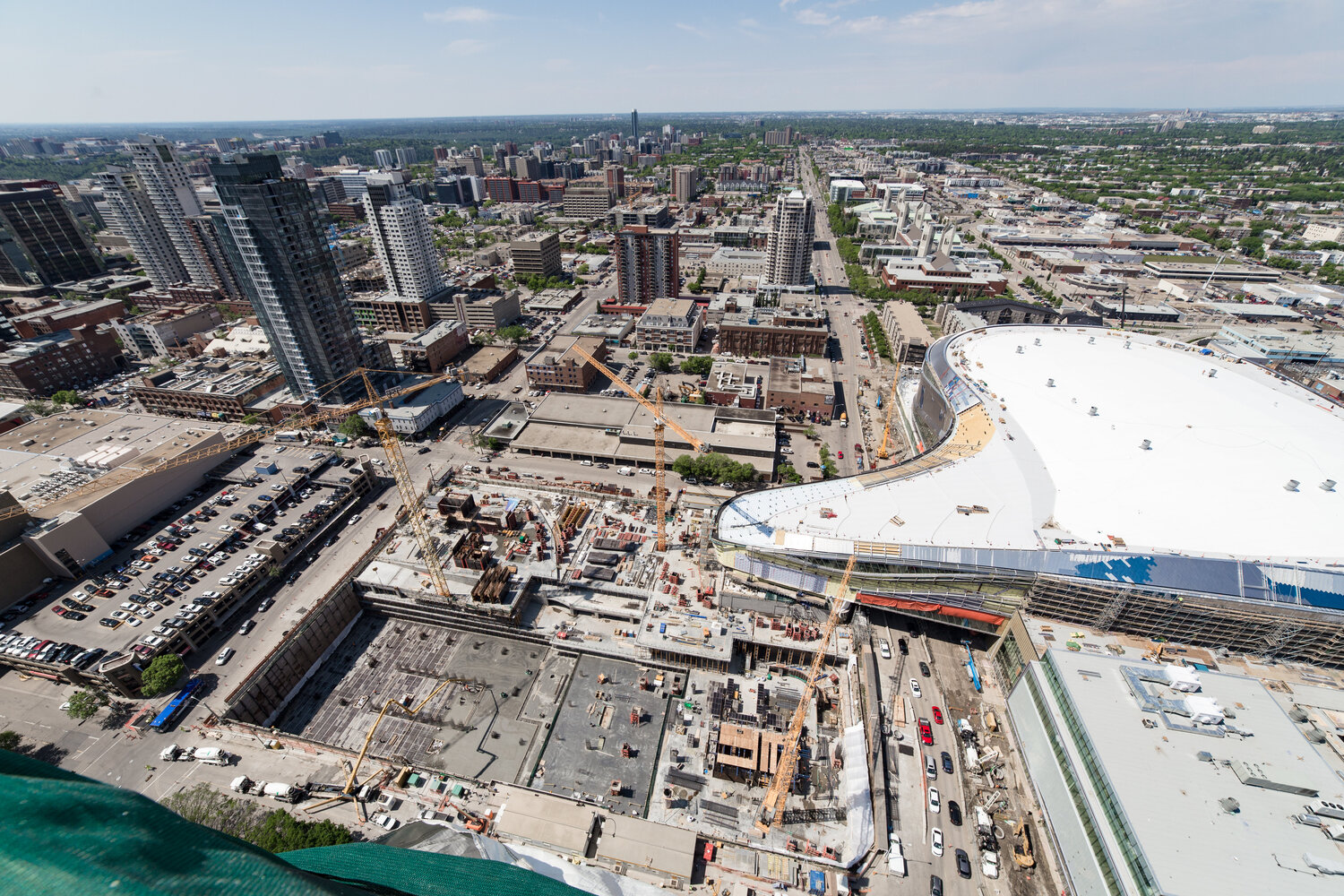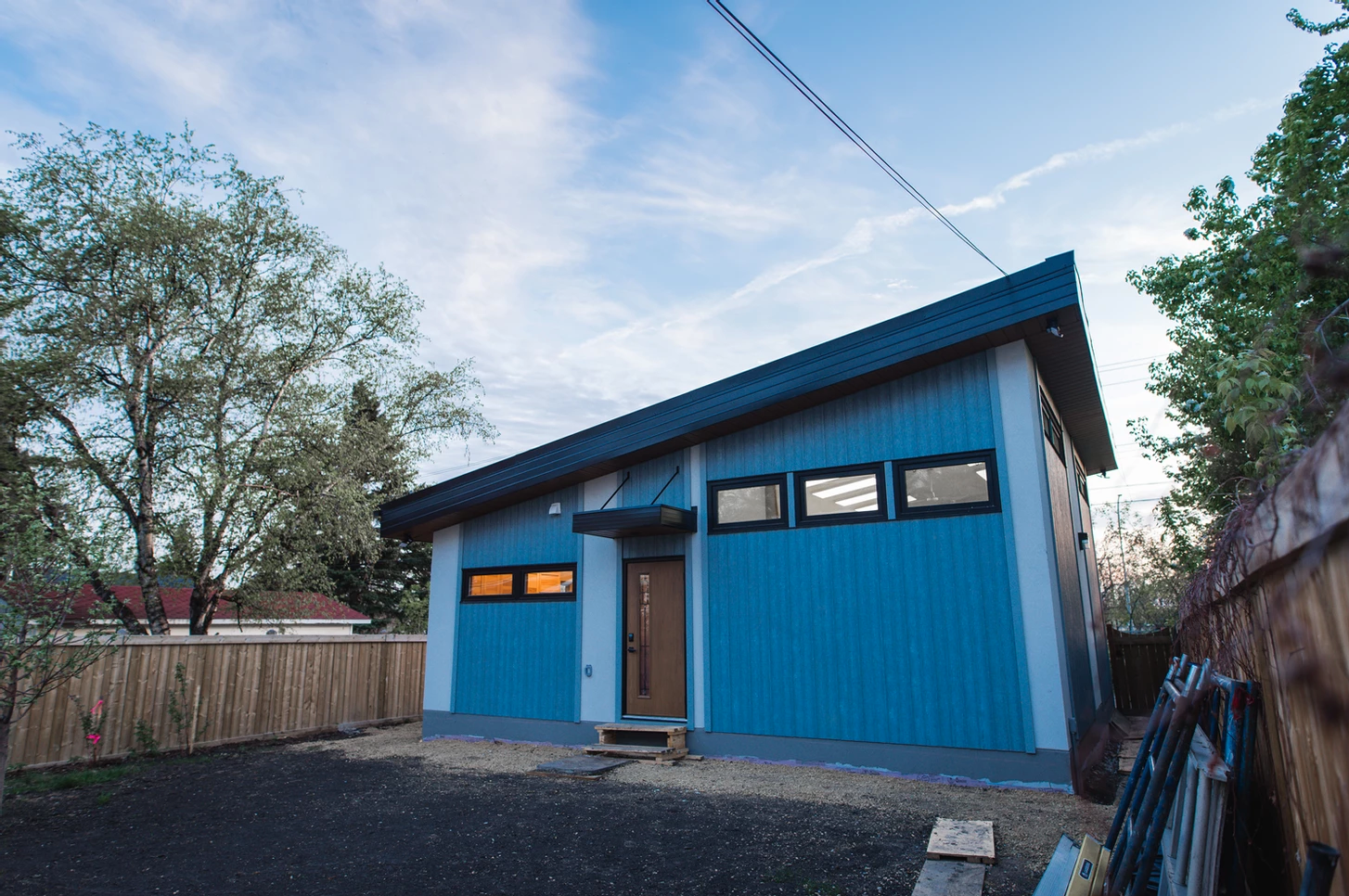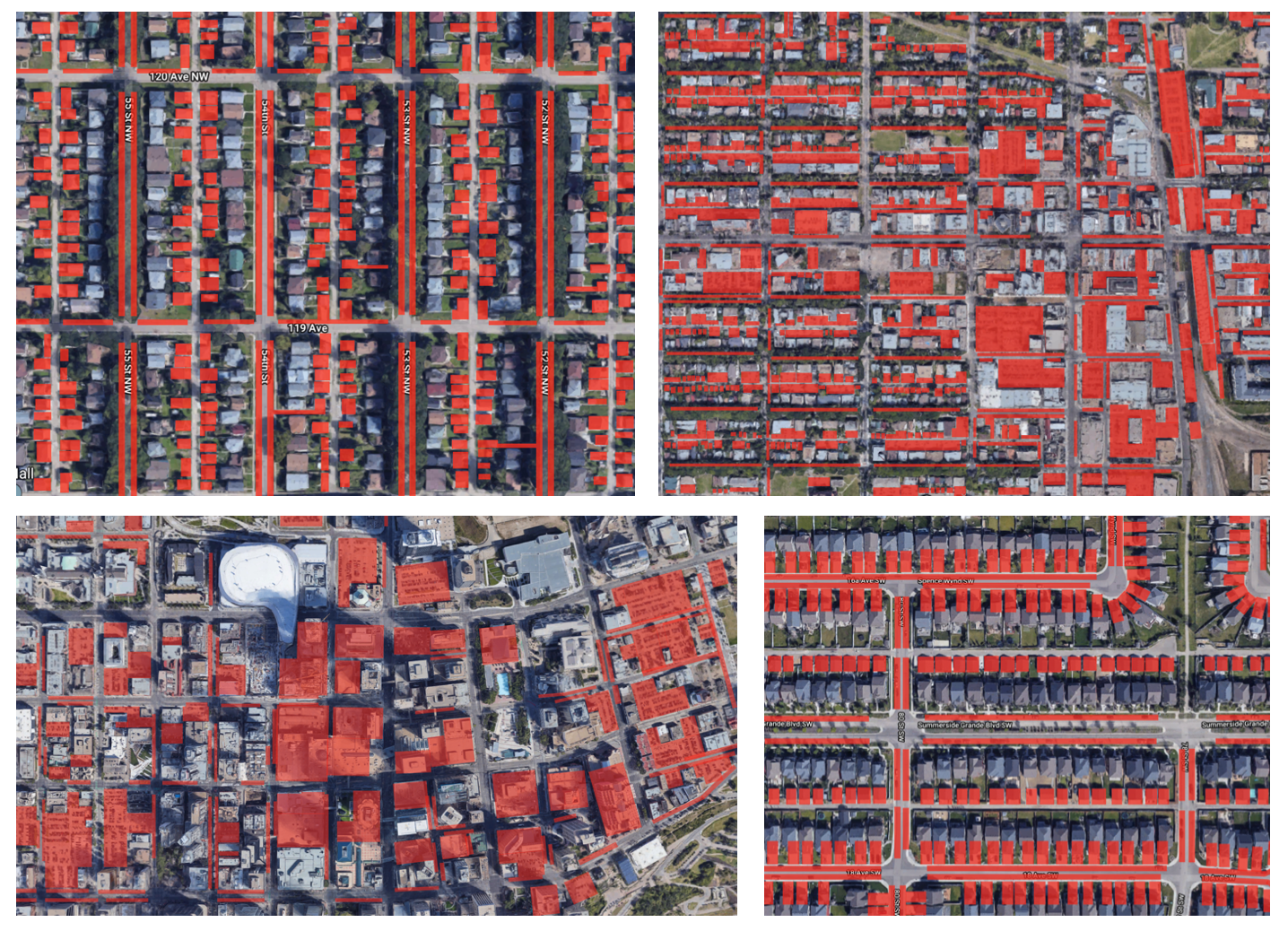Lessons from Canada: How To End Mandatory Parking Minimums
12:01 AM EST on November 23, 2020

Image vai Creative Commons
Back in June, the city council of Edmonton, Alberta voted unanimously to drop its minimum parking requirements. It was the first major Canadian city to do so. In a subsequent news release, Kim Petrin, development services branch manager for the City of Edmonton said, “Parking is a powerful, but often hidden force that shapes how our communities are designed and influences every aspect of how people live, work and move around.” We at Strong Towns couldn’t agree more: land is a finite, valuable resource, and minimum parking requirements saddle North American towns and cities with unproductive, empty parking spaces. Land that could be an engine for prosperity and well-being instead becomes a costly burden on homeowners, small businesses, and taxpayers.
Towns and cities exploring parking reforms are now rightly looking to Edmonton’s example; there is much to learn there. To hear more about how Edmonton got to the point of abolishing parking minimums altogether, and to get an update on what has happened since the new rules went into effect on July 2—was it parking chaos?—I spoke recently with Ashley Salvador. In May, Salvador wrote an article for us about the upcoming vote. With Travis Fong, she is the cofounder of YEGarden Suites, a nonprofit that helps homeowners in Alberta who want to build accessory dwelling units. (Accessory dwelling units, or ADUs, are also called laneway homes, granny flats, carriage houses, and, in Edmonton, garden suites.) YEGarden Suites was a key partner in the collaborative effort to end parking minimums.
“The Oil Capital of Canada”

From the outside, Edmonton may seem like an unlikely candidate to be the first major Canadian city to end parking minimums—and not just because it is home to the world’s largest parking lot. A major hub for the oil and gas industries, Edmonton’s official slogan since the 1940s has been “The Oil Capital of Canada.” With a population of just under one million people, the city is Canada’s fifth largest. Yet Edmonton sprawls across hundreds of square miles, and its population density—2,190 people per square mile—is markedly lower than many of the most car-dependent cities in the United States, including Phoenix (3,125 people/square mile) and Houston (3,842 people/square mile).
In her article earlier this year, Ashley Salvador explained why Edmonton’s achievement is less surprising for those who know the city well—as she does. Salvador grew up on a farm an hour outside Edmonton, but much of her life was spent inside the city. Her parents commuted to work there, she went to school in Edmonton, and she had extended family there. She left Alberta to attend Dalhousie University in Halifax. At the time Dalhousie was the only university in Canada to offer a program in Sustainability. The school took an interdisciplinary approach—her eventual degree combined sustainability and sociology—that Salvador appreciated. “I started to think not just about our natural environment but about our human habitat,” she says, “and how our human habitat (cities) are either facilitating health and well-being or harming it.”
In her third year of university, in a class focused on the intersection of urban design and sustainability, Salvador did a course-long project on tiny homes and small housing. At the start, her interest in tiny homes was more conventional (“People should be living smaller.” “How do we live lighter on the land?”), but the more she researched the more she realized that context matters: “You may have a tiny home on the edge of town, but if you’re driving in every day, it offsets some of the benefits. I started looking into how tiny homes are being integrated into existing built-up areas and that’s where I came across garden suites.”

ADUs by any name can be a powerful tool for cities, and we extol their virtues often on our site. ADUs can increase the stock of affordable housing, give aging relatives or adult children a place to stay, and help generate rent for homeowners—and they do it all without dramatically altering how a neighborhood looks. “ADUs add pedestrians to the sidewalks, customers to local businesses, and dollars to the tax base that pays for city services,” Daniel Herriges wrote for us in 2018. “And they do all of this while making more efficient use of infrastructure that already exists.” He continues:
ADUs are a quintessentially Strong Towns approach to urban growth and affordability issues: bottom-up, decentralized, incremental, scalable and adaptable. They exemplify the principle of steady, distributed neighborhood change as the antidote to sudden, disruptive neighborhood change.
In her fourth year of school, Ashley Salvador took her interest in garden suites even further, completing a year-long thesis that involved interviewing every garden suite owner back in Edmonton—about 115 of them in all. Her research turned up some interesting findings, attracting the interest of The Globe and Mail, one of Canada’s largest newspapers. For example, Salvador found that nearly half the ADUs in Edmonton were being rented to family or friends, and that more than 70% of garden suite owners had household income of greater than $100,000. What could have been a powerful, broadly available tool to provide affordable housing and generate wealth was primarily benefiting the already-well-to-do.

“From a policy perspective,“ Salvador told the paper, “reducing the cost to build, the cost for permits and reducing the time from conception to completion would make it a more widespread housing type. I know the city is looking into changing the restrictions from discretionary use to permitted, which means neighbours will no longer be given the ability to appeal a project, but I think policy needs to go further to help homeowners in lower- to middle-income brackets, and their family members, to benefit from this as a form of affordable housing.”
Now back in Edmonton, Salvador and Fong founded the organization that would become YEGarden Suites. Many Edmontonians were intrigued by garden suites, but property owners had trouble visualizing the steps that would get them to a finished product. Salvador and Fong booked a space for $15 at the local library. To present, they invited builders, designers, mortgage specialists, and representatives from the city. The event sold out immediately. “We really underestimated the interest,” says Salvador.
And things have only grown from there. Before COVID, YEGarden Suites’s workshops, tours, and other in-person events were regularly drawing between 100-150 people. (Workshops have continued virtually.) Last year, 67 new permits for garden suites were issued in Edmonton, the most ever, and—as of December 2019—more than 350 garden suite permits have been issued there in total.
Ending Parking Minimums
YEGarden Suites does more than just education. “There is a huge advocacy component as well,” Salvador tells me. “We work alongside the city councillors and administration to improve the rules and regulations to a point where it’s actually feasible to build.”
When Salvador and Fong were looking at the obstacles that kept people from pursuing garden suites, they made a list: permitted use vs. discretionary use, size limitations, location restrictions, and more. To that list they also added: minimum parking requirements.
“It really comes down to the allocation of space,” explains Salvador. “You don’t have infinite space in your backyard; you either get to devote it to a place for someone to live, or a place to park your car. If you are mandated by the city to provide two or three stalls, that’s just taking away valuable living space. So someone who wants to build a two- or maybe even a three-bedroom garden suite is now forced to build a tiny bachelor pad instead, with three stalls of parking they don’t need.
“Parking minimums really limited the market and functionality of these suites. In some cases, it limited the accessibility, too—as when someone who wanted to build a granny flat but were forced to put it on the second story to make space for parking.”
It wasn’t just potential ADU owners running into issues with minimum parking requirements, says Salvador, who is also involved with the broader infill housing community in Edmonton. From missing middle development to even larger-scaled ventures, parking minimums were often tipping the scales and making projects inefficient and ultimately unviable.

When making the case to end parking minimums, an important part of the work YEGarden Suites and others did was to ease the fears of residents and elected officials. “City streets will not be flooded with parked cars,” Salvador wrote in May. “Private individuals, businesses, and developers will still provide parking, and the City has tools at its disposal to effectively manage on-street demand to ensure parking is reliably available for those who need it.”
I asked Salvador what has happened since the new rules went into effect in early July. Was there parking chaos? Not at all, and Salvador says that a number of projects have been put forward with limited or no parking.
What’s more, Travis Fong and Ashley Salvador told me, the end of parking minimums, combined with Edmonton’s new Missing Middle Zones, have given property owners an enviable amount of flexibility. In Edmonton, there are a lot of Direct Control zones, areas in which the developer gets to write their own code. Instead of using a conventional, “off-the-shelf” zone, they go through city council and pay a fee to get a special site. Now that the underlying rules—removal of parking minimums, other key changes to zoning bylaws, etc.—are so much better, people who have Direct Control properties are actually asking to revert back to conventional zoning.
In fact, Edmonton is now doing a complete overhaul of its bylaws, a process expected to be completed by 2022—and a process Fong and Salvador hope will change the landscape even more for the better.
Lessons from Edmonton
As I reflected on my conversation with Ashley Salvador—a conversation, by the way, that took place just hours after she successfully defended her Masters thesis—I thought about Strong Towns advocates hoping to end minimum parking requirements in their own town or city. What are some of the lessons they could take away from the experiences of advocates in Edmonton? Here are several that came to mind:
1. Develop a shared vision for your community
Salvador says that, in some ways, she and Fong were lucky to already be embedded in a city thinking carefully about land use, a city with a vision to be more resilient, transit-oriented, and walkable. That vision—Edmonton’s plan for at least a decade—provided the foundation for everything else. “Until you get there,” says Salvador, “it’s hard to have conversations around parking minimums and how it’s going to help us build a more environmentally and fiscally sustainable city. That’s the groundwork that needs to happen.”
2. Don’t try to do it alone
YEGarden Suites was one part of a broad coalition of advocates that included residents, developers, planners, other nonprofits, and more. Collaboration has been in the DNA of YEGarden Suites since its first sold-out information meeting at the library. “We like to situate ourselves between the community, industry, and municipality,” Salvador tells me. “We need all those players at the table...and more.”
3. Empower stakeholders to speak for themselves
“Whenever we’re having conversations around community change or neighborhood change, we find it’s much more powerful if those stakeholders speak themselves to present their perspectives,” says Salvador. “When we go to council, we put together panels of community members who can share their experiences, instead of just me speaking up for everyone.”
Many community members are intimidated by the prospect of speaking up at city council meetings. They don’t know how to register to speak, or what to say. These can be major barriers to direct engagement. So YEGarden Suites holds workshops to give community members the tools, knowledge, and confidence to interact with city officials.
“We like to think of ourselves more as a movement generator, rather than as pure advocacy,” Salvador says. “That’s a critical part of it: giving people the tools they need and empowering them to be part of the conversation.”
4. Communicate in ways people can understand

One of the challenges in advocating for a change like ending parking minimums is that while parking can be a hot-button topic, many people aren’t interested in getting into the weeds of the issue. Something that really impressed me since I started tracking the progress in Edmonton was YEGarden Suites’s commitment to communicating in ways that were accessible to the general public. In particular, I loved their use of striking visuals, including infographics co-created with Municipation. For examples, click here to see an infographic they created about parking minimums in Edmonton, and here for one geared more generally to North American cities.
5. Use dollars and cents
Salvador and Fong told me that having a legitimate parking study was critical in their city, because they were able to base their arguments on data and facts. Salvador: “Being able to say that Edmonton has a 52% oversupply of parking is more effective than claiming that parking minimums are bad because Donald Shoup says so.”
Edmonton’s city councillors are concerned about the budget, she says. They want to be business-friendly and fiscally responsible. The data allowed the conversation to be framed in those terms, to show that ending parking minimums will “create opportunities for investment, more business opportunities, more affordable housing, and more complete communities.”
YEGarden Suite cofounder Travis Fong agrees: “Part of the Strong Towns message is our message, which is that you have to speak to people in multiple ways. And one of the critical ways is using dollars and cents. We worked really hard on that.”
6. Don’t underestimate the incremental approach
The city council’s decision in June to end parking minimums didn’t materialize out of nowhere. Planners and other advocates had been chipping away at parking requirements for about ten years—slowly removing or reducing them in certain areas or for certain uses. A few years ago, parking reformers decided to pursue sweeping regulatory change...but that was only after the foundation had been laid through incremental progress and patient communication.
7. Point to other examples
You may hear from neighbors or city officials that ending parking minimums will result in chaos: a parking shortage, people circling the block endlessly waiting for a precious space to open up, folks opting to shop at the big box store on the outskirts instead of the small business downtown. This is a good time to point out that the movement to end parking minimums is gaining momentum. Cities large—Portland, Buffalo, Hartford—and small—like Sandpoint, Idaho—have discovered that reducing or removing parking requirements works. Here at Strong Towns, we maintain a crowd-sourced map of towns and cities making these changes. The map is filling up fast, and it’s time up to update Edmonton’s entry.
Ashley Salvador says it’s important to have “local community champions” who can communicate effectively, address people’s fears, and point to other cities who have come before you. “That’s one reason we’re so proud that Edmonton took this step—because other cities are already pointing to Edmonton and saying, ‘Well, they’ve done it, and they’re a major Canadian city. So we can do it now.’ It feels safer.”
John Pattison is the Content Manager for Strong Towns, where this article originally appeared. It is republished here with pemission.
Kea Wilson has more than a dozen years experience as a writer telling emotional, urgent and actionable stories that motivate average Americans to get involved in making their cities better places. She is also a novelist, cyclist, and affordable housing advocate. She previously worked at Strong Towns, and currently lives in St. Louis, MO. Kea can be reached at kea@streetsblog.org or on Twitter @streetsblogkea. Please reach out to her with tips and submissions.
Read More:
Stay in touch
Sign up for our free newsletter
More from Streetsblog USA
Talking Headways Podcast: Highway Fighting in Texas
Jeff Wood talks to Megan Kimble about an amazing footnote to the creation of the Interstate Highway system.
The Dawn of the ‘Non-Driver’ Movement: A Conversation with Anna Zivarts
"At the end of the day, there are going to be folks who still can't drive and can't afford to drive — and there are still going to be a lot of us."
Thursday’s Headlines Fight a Suburban War
The way Politico lays out the battle lines, it's not just drivers versus transit users, but urban transit users versus suburban ones.
California Leaders Celebrate Ten Years of Climate Action
Air Resources Board report highlights progress funded by the California Cap-and-Trade Program.
How Car-Centric Cities Make Caring For Families Stressful — Particularly For Women
Women do a disproportionate share of the care-related travel their households rely on — and car-focused planning isn't making matters easier.





